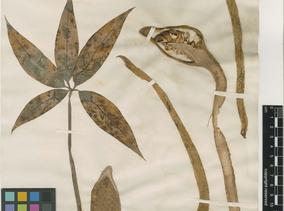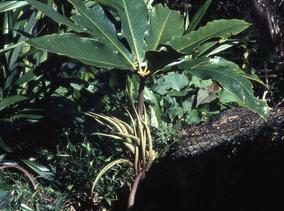Araceae
Protarum sechellarum Engl.
SUMMARY
Seasonally dormant herb. Tuber subglobose to somewhat elongate, erect, to 12 cm long, 6-8 cm diam., light brown outside and conspicuously ringed by closely spaces leaf scars, reddish inside, with solid roots apically, the roots to 4mm diam. LEAF solitary, with several cataphylls basally; cataphylls 12 cm long or less, to 4cm wide, later drying ;petiole 65-120 cm long, ca. 2cm diam., smooth, blackish purple or red-brown to grayish or dirty white, mottled with pinkish, blackish to grayish or olive green; sheath very short, leaf blade subpedate to radiatisect, to 80 cm diam., with (5-)7-11 leaflets, petiolules 3-5 cm long, leaflets elliptic to narrowly elliptic to narrowly elliptic, acuminate at apex, 25-40 cm long and 8-10 cm wide, dark green, sometimes pinkish-silver (on juvenile leaves); midrib prominent, lateral veins pinnate and numerous, forming submarginal collective vein, with marginal vein present; higher order venation reticulate; veins more or less reddish on lower surface, paler than the surface above. INFLORESCENCE solitary, appearing without or with the leaf (or leaves), with cataphylls basally; peduncle short (much shorter than petiole), 9-10cm long, ca. 1cm diam., coloured as petiole; spathe slightly constricted between tube and blade, 13-18 cm long; tube convolute, shorter than blade; blade erect and boat shaped, marcescent (at fruiting stage, the tube persistent and enclosing the infructescence, the upper blade becoming dry); outside more or less coloured as per petiole and peduncle, the inside slightly light grayish in upper part, becoming red to purple toward the base; spadix sessile, 8-12 cm long, much shorter than spathe, the female zone below and conoid, 2-3 cm long, ca. 1.5 cm diam., separated from male zone by a more slender sterile zone covered with narrowly elongated and centrally excavated synandrodes, or partially naked, 1-2 cm long, 0.8-0.9 cm diam.; synandrodes 2-3 mm long; male zone cylindrical to obconical, 1.5-2.5cm long, ca. 0.9 cm diam., with terminal appendix thicker, 2.5-4.5 cm long, 1.3-1.4 cm diam., more or less smooth, grayish to dirty white; flowers unisexual; 3-6 stamens per male flower, connate in a synandrium subprismatic, elliptic to subrhombic ca. 2 mm long, truncate, margin slightly lobed, more or less excavated centrally, with thecae laterally broadly ellipsoid to subglobose, dehiscing by broad apical slit; pollen inaperturate, ellipsoid, 20-22 um long, the exine striate female flower ca. 2 mm tall, gynoesium surrounded by whorl of 4-6 free, thickish staminodes, ca. 1 mm long and wide, oblong to subprismatic; ovary ovoid to ellipsoid, 1-locular, with 4 hemiorthotropous ovules, micropyle elongate, funicle short, placenta basal; stylar region attenuate or nearly absent; stigma 2-4 lobed, much broader than style. INFRUCTESCENCE enclosed by persistent and enlarged basal portions of the spathe, nodding on a benct or curved peduncle owing to its weight, berries densely arranged, ellipsoid to obovoid, 1.2-1.5 cm long, 0.8-1 cm thick bright orange, with persistent stigma remnant, usually only 1-seeded. Seed ellipsoid-oblong to ovoid, 0.7-1 cm long, 0.4-0.5 cm diam., the testa costate, dark to blackish brown; embryo small, flattened and disc-like; endosperm copious. Chromosome number 2n = 28



